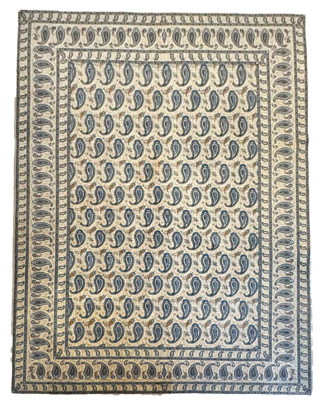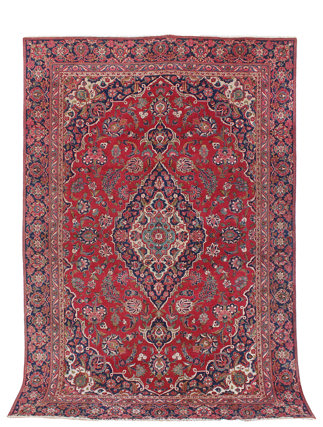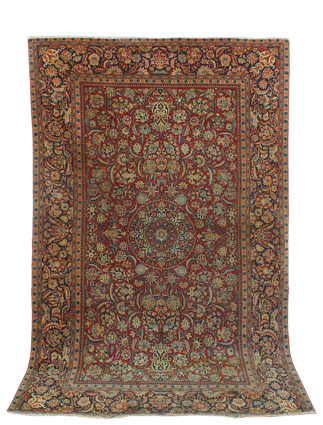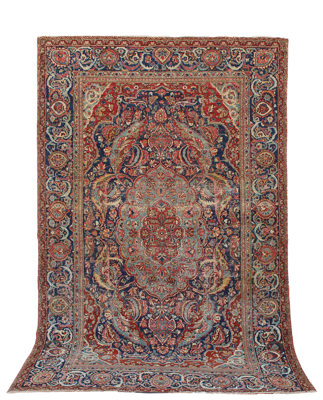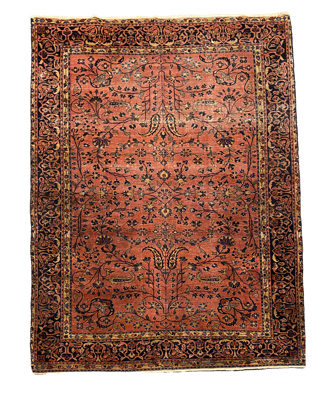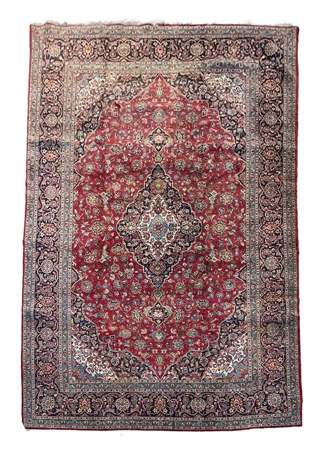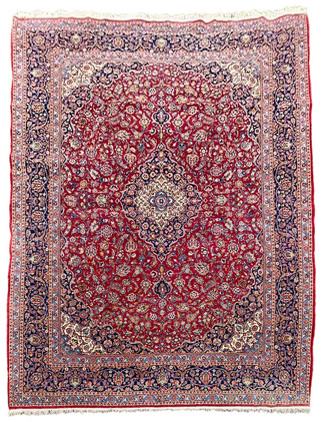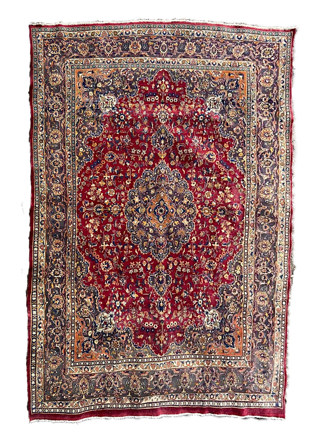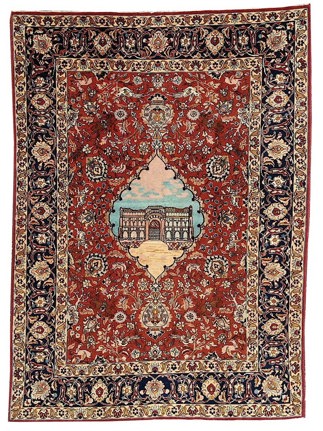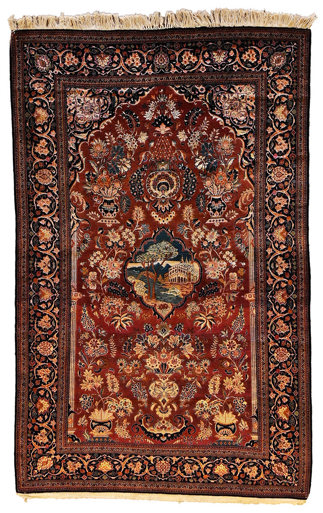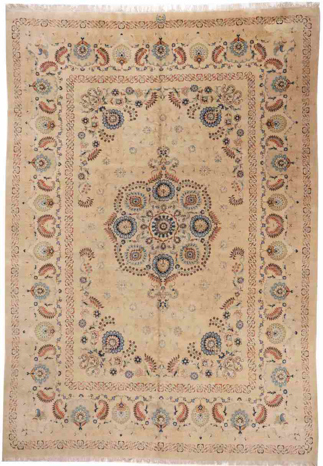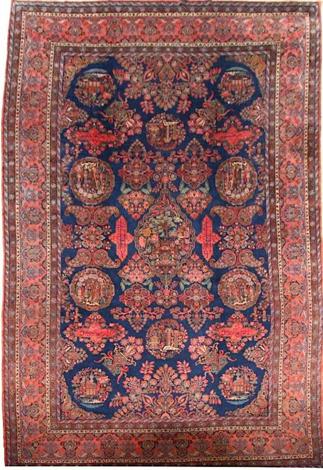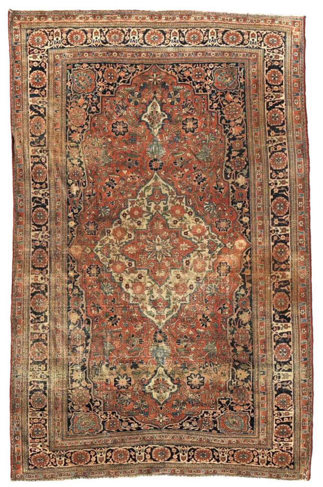Frequently Asked Questions
- What makes antique Kashan rugs valuable compared to vintage or modern Kashan pieces?
Value tends to follow a constellation of factors rather than a single star: age, condition, materials, rarity, drawing finesse, size, and provenance all play their parts. Antique Persian Rugs from Kashan (100+ years) often showcase a depth of wool quality—oily, resilient, tightly clipped—that, coupled with mature dye chemistry, produces that coveted “old colour”: saturated yet calm, luminous without glare. Borders in good antiques read like measured music—confident spacing, flowing vine scrolls, and palmettes that sit without crowding. The surface patina of a well-preserved antique—soft, almost velvet-like under raking light—is a tactile pleasure modern production struggles to emulate.
Vintage Persian Rugs from the mid-20th century can be exceptionally robust and are often the smart choice for buyers prioritising durability and scale with sensible budgets. They commonly carry Kashan’s signature thick pile and disciplined weave, but may be a notch more standardised in drawing and commercial in palette. The very finest modern Kashans exist, of course, but scarcity and historic aura push the most exceptional antiques to the top, especially in rare sizes (palace, long-and-narrow, or unusually large squares/near squares) or superb original condition.
In brief: antiques command premiums for maturity and rarity; quality vintages deliver formidable durability and value; moderns occupy a varied middle. Across all, Kashan’s reputation for dense, long-wearing construction remains a constant, underscoring why the category is so respected among Persian Rugs.
- How do I identify a Kashan rug by design and weave?
The classic Kashan blueprint is unmistakable once learned. Centre-field: a large lobed medallion, often with pendants at the north and south, floating in a field of scrolling arabesques and palmettes drawn with urban precision. Corners echo the medallion’s geometry, and the border suite is clear-headed: a generous main border with palmettes linked by vines, flanked by disciplined guard stripes. Colourways frequently include madder red grounds or deep indigo/navy, with ivory as contrast and sky blue or teal as accents. The overall impression is formal, balanced, and approachable—an urbane branch of Persian Rugs that sits gracefully in both traditional and transitional rooms.
Structurally, expect asymmetric knots on a cotton foundation with tightly beaten wefts. The handle is dense yet supple; shake the rug and it should feel weighty rather than flimsy. Kashan’s wool is a signature feature: abundantly woolly, clipped to a thick pile that reads plush underfoot. On the reverse, knots should appear consistent but human—no laser-straight factory regularity. Think “discipline with a heartbeat”. Knot density in Kashan is more than adequate for clean drawing, but remember: crisp motifs and resilient handle come as much from yarn quality and loom tension as raw KPSI.
- What’s a typical price range for Persian Kashan rugs by size and age (vintage vs. antique)
Pricing stretches across a spectrum formed by size, age, palette desirability, condition, and workshop quality. In practical terms, Kashan offers unusual value at scale: because the city specialised in larger formats (3 × 2 metres and up), many Vintage Persian Rugs from Kashan are well-priced relative to their sheer square meterage, particularly compared with certain Tabriz or Isfahan pieces in similar sizes.
In the vintage band, expect sensible pricing for solid room sizes, with premiums for especially attractive palettes (balanced reds, deep blues, elegant ivory fields), crisp drawing, and high, even pile. Antique Persian Rugs from Kashan with superb wool, mellowed colour, and minimal restoration will sit higher, with prices stepping up again for rare dimensions or exceptional early workshop work. Scatter sizes exist but are less emblematic for Kashan; the market understands Kashan as a large-room solution, and pricing echoes that strength.
For clients mapping budgets, the takeaway is simple: if you need a generous classical Persian Rug with serious durability, vintage Kashan is a strategic category. If you want the poetry and rarity of the best antiques, anticipate the uplift—and the long-term satisfaction—accorded to distinguished pieces.
- Do Kashan rugs hold or increase in value over time?Historically, quality Persian Rugs hold value better than trend furniture because they straddle art and utility. Kashan’s case is particularly strong: the weave is sturdy, the wool is thick and long-wearing, and the design language is timeless. Value retention begins with careful buying—sound condition, honest restoration, appealing colour—and continues with responsible stewardship: periodic professional dusting and wash, rotation to even wear, and sensible underlay.Antiques with excellent wool and balanced colour often grow more beautiful with age as reds and blues relax and darker outlines oxidise slightly, yielding a softer, deeper register. Vintages do well too, especially when they retain their original pile and haven’t suffered harsh chemical cleanings. While no one should buy Persian Rugs as speculative investments, Kashan sits comfortably among categories that historically preserve worth while delivering decades of daily usefulness.
- What KPSI (knots per square inch) is common for Kashan, and how much does it matter?
KPSI is a useful data point, but not a verdict. Kashan typically inhabits a medium-fine band; enough to articulate flowers, palmettes, and tendrils with poise, not so high that the surface becomes delicate. In Keshan Rugs, resilience flows from three allied choices: high-quality, well-plied wool; firm, even weft beating; and workshop discipline that keeps tension consistent across the field.
So, rather than chasing numbers, read outcomes. Do floral outlines look clean and confident? Does the rug lie flat and feel weighty with a responsive, cushioned step? Does the back show tidy, slightly varied knot rows—evidence of the hand rather than the machine? In the ecosystem of Persian Rugs, Kashan proves that balanced construction and generous pile often matter more than raw density.
- How do Kashan rugs differ from Nain, Isfahan, or Tabriz rugs?
Each urban centre expresses a distinct aesthetic and feel. Kashan is classical and practical: bold reds and deep blues offset by ivory, dense woolly pile, and sizes that anchor living and dining rooms with ease. Nain leans pale and ethereal—ivory grounds, celadon or denim blues, finer counts, and sometimes silk outlining—sublime but often a touch more delicate in impression. Isfahan tends to be finer still, with jewel-like detail and frequent silk highlights, made for formal spaces where one admires from above as much as walks upon. Tabriz is protean—capable of enormous range from firm workshop pieces to curatorial fineness—with drawing that can favour architectural clarity.
In practice, Kashan is the consummate “liveable” city weave: thick pile, disciplined structure, and a language of ornament that plays brilliantly with timber, leather, and stone. For buyers exploring Persian Rugs by lifestyle rather than by museum taxonomy, Kashan often emerges as the most forgiving and robust daily companion.
- Which Which Kashan design motifs and colours are most typical?
Expect a generous medallion with pendants, floating amid scrolling vines and palmettes that read as continuous movement rather than isolated emblems. The palette centres on saturated madder reds and deep indigo/navy, with ivory to aerate the composition. Accent blues—sky, teal, turquoise—appear in flower hearts and outline touches. Guard stripes support a well-scaled main border populated by palmettes linked on a vine.
In interiors, red-ground Vintage Persian Rugs from Kashan supply instant warmth and a sense of history, especially in Victorian or Edwardian rooms with original joinery. Navy or indigo fields behave almost like night skies—showing off brushed brass, glass, and lighter upholstery above. Ivory grounds, meanwhile, brighten townhouses and mews properties where daylight is precious. The cohesion of Kashan borders means the carpet reads as one calm statement rather than a busy patchwork—precisely why decorators reach for Kashan when they want “traditional” without clutter.
- Are antique or vintage Kashan rugs suitable for high-traffic rooms?
Very much so. The wool used in Keshan Rugs is naturally oily and springy, clipped into a thick pile that absorbs impact and bounces back. The city-workshop structure—tight weft packing on a cotton foundation—keeps the whole plane stable, resisting buckling and premature channel wear. These are Persian Rugs meant for parlours, halls, dining rooms, and salons—i.e., real rooms where people gather.
Care rituals are simple: rotate once or twice a year to even the sunlight and footfall; use a quality underlay to stabilise and cushion; place furniture glides under sharp legs; and institute a “mats at entrances” habit to curb grit. Anecdotally and historically, it’s common to encounter century-old Antique Persian Rugs from Kashan still doing daily duty with grace, which says everything about the category’s stamina.
- How should I clean and maintain a Persian Kashan rug (home care vs. professional wash)?
Day-to-day care begins with routine vacuuming using a suction-only head, weekly or fortnightly according to traffic. Blot spills promptly with a clean, undyed cloth—press rather than scrub—and work from the edge of the spill inward to prevent wicking lines. Avoid aggressive supermarket chemicals; the chemistry of natural fibres and dyes in Persian Rugs warrants professional-grade prudence.
Because Persian Keshan Rugs have a naturally deep, woolly pile, they tend to harbour fine dust at the base—material that ordinary vacuums cannot reach. Over time, this compacted dust dulls colour, mats pile, and creates conditions that suit clothes moths. London House Rugs has an in-house team of rug cleaning and restoration experts who understand how to treat Antique Persian Rugs, Vintage Persian Rugs, and modern Keshan Rugs sympathetically. As part of our specialist wash process, we use a professional dust-extraction machine engineered to dislodge and remove years of compacted dust from deep within the pile before any wet work begins. This restores bloom and resilience and reduces the risk of moth, which thrive in dusty, undisturbed fibres. During intake we’ll also assess for prior poor repairs; dealing with small issues early prevents costly interventions later. In essence, a periodic professional dusting and wash keeps a Kashan performing like the durable Persian Rug it was built to be.
- What size Kashan rug works under a sofa or dining table, and should it go under or in front?
Kashan excels at “room-making” sizes. In living rooms, a 300 × 200 cm Kashan typically allows front sofa legs and adjacent chairs to sit on the rug, unifying the seating plan and avoiding the “floating postage stamp” look. If the architecture allows, 350 × 250 cm or larger can ground the entire arrangement, bringing generous negative space around furniture for a calm, intentional composition. Because Kashan is a city weave associated with larger formats, this is one of the most cost-effective ways to achieve a grand traditional statement among Persian Rugs.
In dining rooms, measure the table at full extension and add roughly 60–70 cm on each side so chairs slide back while staying on the rug. The dense, cushioned pile of Keshan Rugs copes well with chair abrasion, but fit smooth glides and encourage lifting rather than dragging. In narrow London townhouses, consider a long Kashan runner to animate a corridor or galley kitchen; the controlled border rhythm gives a coherent sense of movement without visual noise.
- Which rug pad is best under a Kashan on wood, tile, or carpet?
Underlay is the quiet partner that helps a Kashan perform at its peak. On hard floors—timber, limestone, terrazzo—a dense natural-rubber or felt-and-rubber composite underlay is ideal: it grips, cushions the thick pile, and protects the cotton foundation from repeated hard impact. Avoid cheap foams that degrade, bond to finishes, or create uneven compression points. On fitted carpet, use a firm pad engineered to lock rug to carpet without producing a trampoline effect; you want stability and breathability, not bounce.
The right underlay sharpens the feel underfoot, lowers noise, and lengthens service life by reducing micro-abrasion at the pile tips. It also minimises creep, keeping the disciplined geometry of a Kashan square to the room—important when your Persian Rug is effectively the decorative anchor of the space.
- Can Kashan rugs be used with underfloor heating?
Yes—very comfortably, with appropriate settings. Wool is a natural insulator, so a dense Kashan will transmit heat more slowly than a flatweave, but it remains entirely compatible with most hydronic or low-temperature electric systems. Maintain surface temperatures within manufacturer guidance (commonly below ~27°C), and avoid impermeable pads that trap heat. A breathable felt underlay is typically ideal for airflow and stability. London House Rugs supplies specialist, breathable underlay specifically designed for use over underfloor heating, allowing even heat transfer while protecting the foundation and eliminating hot spots. As with any fine textile, gradual seasonal changes are kinder than abrupt ones, helping your Persian Rug acclimatise without stress.
- Is it safe to buy a Kashan rug online—what certificates, appraisals, or provenance matter?
It is not only safe; for many clients it’s the most efficient way to compare scale, palette, and drawing across multiple options. The key is transparency. Insist on natural-light photography (front and back), precise measurements, pile height notes, honest condition disclosures (re-fringing, end reductions, re-weaves), and an uncomplicated returns policy. Short videos help you read sheen and pile direction—subtleties that static images can flatten—so you can better imagine the rug in your changing daylight.
Certificates and appraisals can support attribution and insured value, but confidence ultimately comes from the vendor’s expertise and candour. Measure your space carefully, map furniture footprints, and request additional images of edges, corners, and the back. London House Rugs has over 45 years of experience supplying authentic hand-knotted rugs, including Persian Keshan Rugs, and we prize accuracy in attribution, forthright condition reporting, and thorough aftercare as much as aesthetics. That combination—knowledge, selection, and service—lets you choose a Kashan online with the same assurance you’d have in-person, and is precisely what discerning buyers look for when investing in Persian Rugs.
- How do I spot common repairs or issues in older Kashan rugs (re-fringing, re-weaves, reduced ends)?
Begin at the perimeter, where issues most often appear. True structural fringe is the continuation of warp threads; if you see a thick machine-stitched strip, that’s cosmetic. A sympathetic re-fringe that continues the original warps is perfectly acceptable conservation. Examine side cords (selvages): they should feel integrated and proportional. Over-heavy replacements produce a ropey outline that distracts the eye and, left unchecked, can distort alignment.
Scan the field in raking light to catch small re-weaves; they may reflect differently or show slightly denser knot packing on the back. Many Antique Persian Rugs have reduced ends: if field motifs appear abruptly truncated just before the border, the ends may have been cut back to remove damage. This needn’t be disqualifying if priced and finished properly; the question is one of honesty and structural soundness. Finally, bend the rug gently and listen for stiffness or cracking—signs of a cotton foundation stressed by poor historical washing.
When work is needed, choose expertise. London House Rugs’ skilled expert restoration team undertakes conservation to the highest standards, prioritising structural integrity and visual coherence with original materials and methods. That’s how Keshan Rugs retain both their beauty and longevity—practical conservation, not cosmetic shortcuts.
- Are there ethical or sustainability considerations specific to Kashan production and restoration?
Absolutely. Hand-knotted Persian Rugs are inherently more sustainable than disposable floorcoverings: natural materials, repairable construction, and lifespans measured in decades or generations. Seek provenance from workshops and dealers who value skilled labour, fair practice, and long-term conservation over quick cosmetic fixes. Avoid harsh chemical washdowns that strip life from the pile or destabilise dyes; they may look dramatic in photos but shorten service life.
For restoration, ask for reversible techniques where possible, careful colour-matching, and sympathetic materials (hand-spun wool in visible areas; appropriate cotton for foundation work). A Kashan maintained this way can outlast multiple decorative schemes, moving from one home to the next as a piece of inherited culture. That is sustainability in the truest sense—durability, reparability, and continued relevance—exactly what collectors and design-led homeowners value in Persian Rugs.
- Why choose London House Rugs for Kashan rugs (sourcing, expertise, restoration, aftercare)?
Because we combine rigorous curation with practical aftercare. We select Keshan Rugs for authenticity, condition, and design clarity—dense pile, disciplined weave, and palettes that sit naturally in British interiors. Our view is that a fine Persian Rug must be both beautiful and liveable; that’s why we test for stability, disclose condition with precision, and guide you on the correct underlay, placement, and maintenance cadence.
Our restoration partners—and our in-house team for cleaning and conservation—work to preserve rather than overwrite, using methods and materials that respect the original construction of Antique Persian Rugs and Vintage Persian Rugs. We help you size correctly (particularly those 3 × 2 m and larger formats where Kashan excels), advise on light and traffic, and remain available for aftercare long after installation. The result is a straightforward promise: you’ll get a Kashan that looks right, wears well, and feels properly anchored in your room—exactly what one hopes for when investing in the best traditions of Persian Rugs.
- Where do Kashan rugs come from, and what is their historical background?
Kashan—also written Keshan—sits in central Iran on the old Silk Road, a region long associated with distinguished textiles. The Kashan rugs that most of us mean today emerged from a late-19th to early-20th century renaissance, when organised city workshops consolidated a language of classical Safavid aesthetics—balanced medallions, articulated vine scrolls, palmettes—and applied modern discipline to yarn preparation, dyeing, and loom practice. Unlike village or nomadic Persian Rugs, Kashan is an urban weave: planned, repeatable, and architecturally composed.
Earlier workshops worked with natural dyes; by the early 20th century, carefully controlled synthetics joined the palette. Done well—and Kashan workshops often did it very well—the result was handsome, saturated colour that matured beautifully, a reason Vintage Persian Rugs from Kashan remain sought-after. The city’s reputation for large room sizes—3 × 2 metres upward—grew from real domestic need, supplying durable “palatial” looks to European and Middle Eastern homes. The Kashan promise, historically and now, is the blend of courtly elegance with practical sturdiness: a refined Persian Rug you can live on, not just look at.
Today, Antique Persian Rugs from Kashan (roughly pre-1920s) are prized for their graceful drawing, mellowed colour, and often exceptional wool. Mid-century examples deliver consistency and durability, frequently at attractive price points for their scale. The category as a whole stands as one of the most usable city weaves in the landscape of Persian Rugs.
- How can I tell if a Kashan rug is authentic (not machine-made or a non-Kashan Persian)?
Authenticating a Kashan is an exercise in reading structure, handle, drawing, and palette together. Start with the foundation: authentic Kashan carpets are hand-knotted on cotton warps and wefts, with a pile of dense, lustrous wool that feels oily to the touch and springs back after compression. Lift a corner and inspect the reverse; you should see rows of asymmetric (Persian/Senneh) knots that are tidy but not mechanically perfect. This graceful irregularity is your first assurance of a hand-knotted Persian Rug, not a loom-programmed imitation. The back will reveal clear, individual knot heads and weft shots; machine-made backs look grid-tight, overly uniform, and often “boardy”.
Fringe is another structural tell. In authentic Persian Keshan Rugs the fringe is simply the warp ends brought through and finished; in many machine-made pieces the fringe is a separate, sewn-on strip. Run a clean hand over the pile: Kashans are famously woolly—thick, resilient, and deeply cushioned—yet the carpet should not feel floppy. That density is paired with a disciplined urban weave, giving a reassuringly steady handle you can sense when you shake the rug.
Design language matters. Kashan drawing is urbane and measured: a lobed central medallion with pendants to north and south, scrolling vines, palmettes, and blossoms that are carefully composed. Palettes are classical—madder reds, deep indigo or navy, ivory grounds for brightness—and the border system is coherent rather than busy, with a strong main border flanked by proportionate guards. If the drawing trends angular and rustic, you may be in Heriz territory; if it’s extremely pale with filigree fineness, perhaps Nain or Isfahan. True Kashan speaks the courtly dialect of city-weaving Persian Rugs—refined, balanced, and quietly opulent.
For newer buyers, the simple checklist is: hand-knotted back with slight irregularity, cotton foundation, integral fringe, dense woolly pile, classical medallion layout, disciplined floral borders. For seasoned collectors, subtleties such as dye chemistry, outline precision on floral serrations, and the “music” of the border rhythm further cement attribution.
